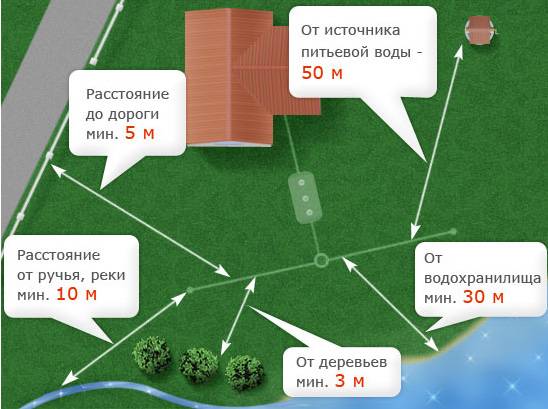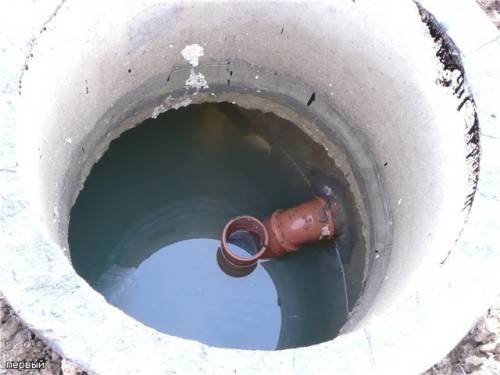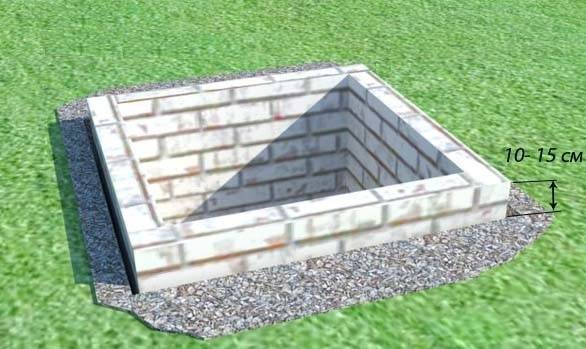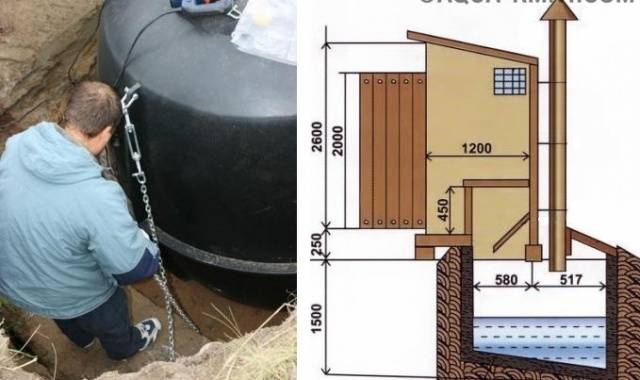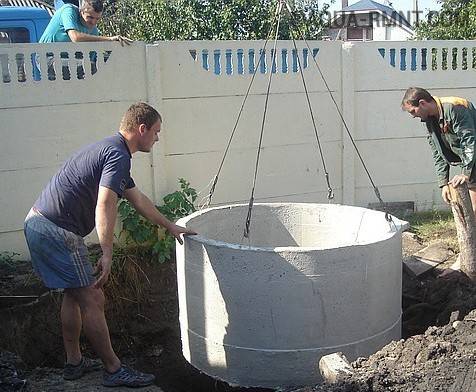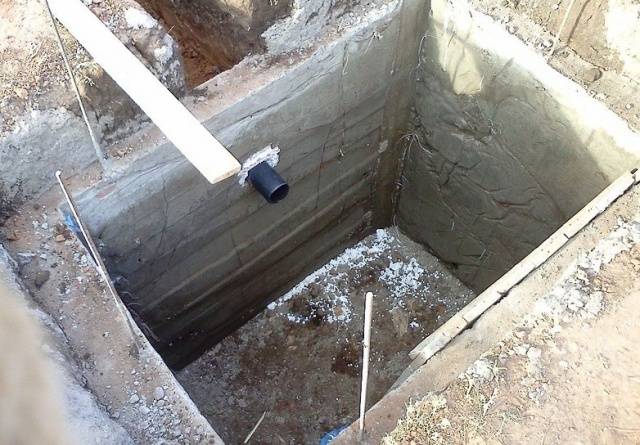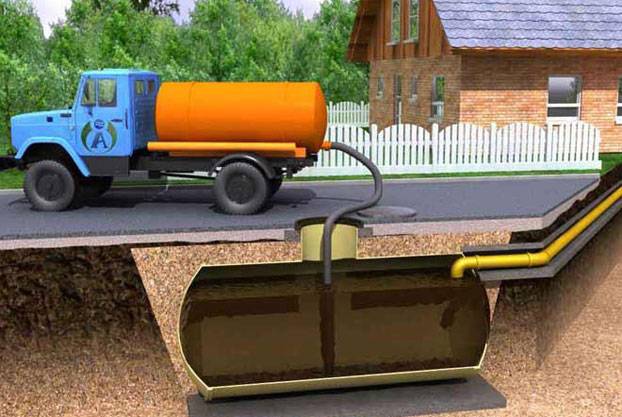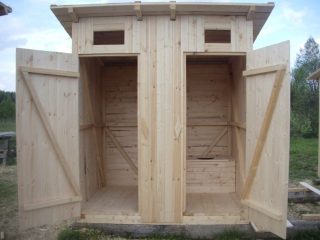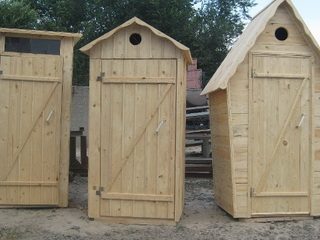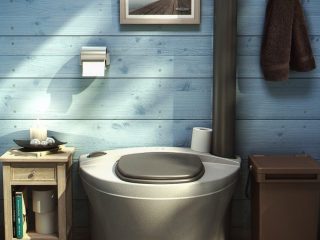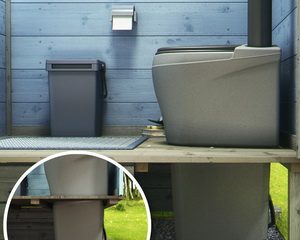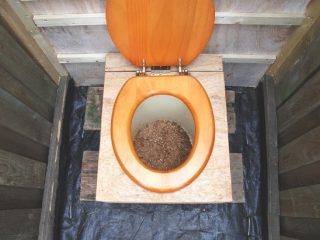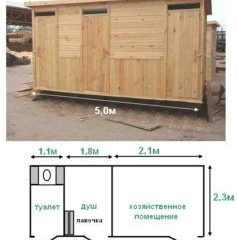Content
The design of the country toilet is chosen, guided by the frequency of the owners' stay on the site. And if in a small, rarely visited dacha, you can quickly build a simple toilet, then this option will not work for a residential and frequently visited country house. Here you will need a well-equipped outdoor toilet or a bathroom inside the house. Whichever of these options is chosen, you will have to dig a tank for collecting sewage under them. Today we will consider the parameters for determining the depth and width of the pit for the toilet in the country, and also touch on the process of its construction.
Cesspool placement rules
Certain rules apply to the placement of a summer cesspool. This is especially true for leaky tanks, where the contact of sewage with the ground occurs. Before you build a toilet in the country with your own hands, determine the location of the cesspool, taking into account the following parameters:
- The location of the cesspool in the country is determined so that it is not closer than 25 m to any source of water. It is important to take into account the relief of the suburban area. In hilly terrain, the reservoir is located lower in relation to the site with a residential building and a water source. Even if the cesspool overflows, sewage will not be able to penetrate into the well or under the foundation of the house. The relief of the suburban area and the location of water sources must be taken into account in relation to the neighboring site.
- To residential summer cottages, especially if they have a basement or cellar, the cesspool should be placed no closer than 12 m.The distance of 8 m is maintained from the pit to the shower or bath, but it is allowed to approach the outbuildings up to 4 m.
- Neighboring summer cottages are separated by a border. So the cesspool cannot be dug closer than 1 m to this demarcation line, as well as to the fence. Sanitary standards do not allow planting trees closer than 4 m to the sewage tank. For shrubs, this figure is 1 m.
- The location of the cesspool in the country is calculated taking into account the direction of the wind. According to their observations, in which direction the wind most often blows, the tank is positioned so that the smell from it evaporates in the opposite direction from residential buildings.
- The groundwater level strongly influences the construction of the cesspool. If they are at a depth of 2.5 m, any type of tank can be erected. With a high location of the water layer under the cesspool, it is necessary to install only an airtight container or build a country toilet of the powder-closet system.
These rules apply to all country toilets, except for powder closets and backlash closets, since the waste in them does not come into contact with the soil.
Calculation of the volume of a summer cesspool
After the location of the pit for the toilet in the country has been determined, it is necessary to determine its size. For an ordinary street toilet, a cesspool is dug 1.5-2 m deep. The dimensions of the side walls of the tank are taken arbitrarily, for example, 1x1 m, 1x1.5 m or 1.5x1.5 m. It makes no sense to dig a very wide pit, since it is more difficult cover on top.
When a cesspool in a country house is being built for a sewage system coming from a residential building, a bathhouse and other similar buildings, some calculations will need to be made here.First of all, they are repelled by the number of people living in the country. The basis is the average daily water consumption by one person - 180 liters. Having made the calculations, you can find out that three people in the country in a month will fill the cesspool with drains of about 12 m3... However, the cesspool is not done end-to-end, so with a margin the volume will be 18 m3.
If there is a washing machine and other water-folding equipment in the country house, the number of drains is taken into account according to the passport data of the devices.
In any case, the cesspool does not dig deeper than three meters. If this volume of the tank in the country is not enough, it means that you will have to pump it out more often or install a septic tank, where the treated wastewater will drain onto the filter field and be absorbed into the ground.
Construction of a cesspool in the country from different materials
When the question arises of how to dig a hole for a toilet in the country, one answer suggests itself - with a shovel or an excavator. Another thing is to deal with the arrangement of the reservoir. Different materials are used for its construction. The service life of the cesspool depends on how correctly the construction technology is followed.
It should be noted that summer cottages are sealed and with a filter bottom. The first ones need to be pumped out more often, and the second ones pollute the soil and groundwater. In general, leaking cesspools are prohibited by sanitary standards, but they continue to be built in summer cottages.
Brick pit with a sealed and filtering bottom
The first step is to dig a pit under the tank. This is best done with a shovel. The volume is small, but you get an even pit. It is advisable to give the tank a square or rectangular shape. So, it is easier to lay brick walls. The size of the dug hole should be larger than the usable volume of the tank. First, the thickness of the brick walls is taken into account. Secondly, the structure will need to be waterproofed from the outside, where a certain gap between the wall and the ground will be required.
After the foundation pit has been completely dug out, they begin to arrange the bottom. For a sealed cesspool, the bottom of the pit is firmly rammed. A sand cushion with a thickness of 150 mm is poured on top, and again tamped. Along the entire bottom of the pit, halves of red brick are loosely laid out, and a reinforcing mesh is sorted out on top. You can make it yourself from reinforcement by tying the rods with wire. After that, a 150 mm layer of concrete with crushed stone is poured and allowed to harden.
If the bottom of the cesspool is filtering, a 150 mm sand cushion is poured into the pit, and a layer of coarse gravel or pebbles of the same thickness is added on top. To erect the walls of the cesspool around the perimeter of the pit, a small foundation is poured out of concrete using reinforcement.
When the concreted bottom or foundation is completely frozen in 10 days, they begin to lay out the walls of the cesspool. Usually, the construction of the tank is carried out in half a brick, and silicate blocks are not suitable for these works. They decompose in the ground. It is best to use red brick. The cinder block tank will, of course, last the longest. The finished walls of the cesspool are plastered with concrete mortar or I simply seal the seams, but they are treated with bitumen mastic on the inside and outside. Waterproofing will make the cesspool airtight and prevent the brick from collapsing.
The prepared toilet pit must be covered. If there is no ready-made concrete slab, we will consider how to make one yourself:
- At the time of manufacture of the slab, the gap between the walls of the pit and the brick cesspool must be covered with soil and tightly rammed.Around the perimeter of the brick tank, the soil layer is cleaned to a depth of 200 mm. Here the concrete bulge will be poured, which serves as the stop for the slab.
- The cesspool itself is covered with sheets of tin. From the bottom of the logs, temporary supports will have to be made so that the concrete solution does not bend the thin formwork.
- A reinforcing mesh with 100 mm cells is knitted from reinforcement with a thickness of 12-15 mm. The metal structure is laid on top of the formwork. At this time, a hole must be provided above the pit. Additional reinforcement is laid around the future hatch and formwork sides are installed so that the concrete does not flow into the pit.
- The solution is prepared from cement grade M400 and sand in a ratio of 1: 3. It is advisable to add rubble or other stone filler. The slab is poured in one go.
The crude solution is lightly sprayed with water for two days. When the concrete sets, the slab is moistened again, covered with polyethylene, and left to gain strength for at least a month.
Cesspool for a country toilet from a plastic tank
A cesspool from a plastic tank plays the role of a storage tank. Under the PVC tank, a pit is dug a little more in size. It is enough to maintain a gap of 200 mm between the tank and the walls of the pit. The bottom is cemented according to the same principle as for a brick cesspool. However, even at the stage of manufacturing the reinforcing mesh, metal loops are provided. They should protrude from the concrete in height. In the future, a plastic tank will be tied to the hinges.
When the concrete is completely solidified, a plastic tank is lowered into the pit. It is tied with cables and fixed to the loops protruding on the plate. This fixation will prevent the light barrel from being pushed out of the ground by groundwater. The next stage involves backfilling the gap between the walls of the pit and the PVC tank. It is better to do this with a dry mixture of five parts of sand and one part of cement.
Above the plastic cesspool, you can pour a concrete platform.
The use of concrete rings for the construction of a cesspool in the country
It is possible to make a cesspool from concrete rings according to the principle of a constructor - quickly. However, the help of lifting equipment is needed here. The pit is dug in the same way as for a plastic container. The arrangement of the bottom is no different in the case of a brick cesspool. That is, it can be filtering or hermetic. In the second case, you can resort to a little trick. There are concrete rings with a cast bottom. Installing one such specimen on the bottom of the pit will save you from unnecessary work on concreting the bottom.
Reinforced concrete rings are lowered into the pit, placing them on top of each other. If there are connecting locks at the ends, the rings are joined dry. Between the flat ends, it is advisable to lay a layer of concrete mortar for sealing. Moreover, such rings are pulled together with metal brackets to avoid their shift.
Further work consists of the same waterproofing of the walls of the reinforced concrete tank and backfilling. It is better to cover the top of the ring with a finished reinforced concrete plate with a hatch. If it is not there, you will have to concrete using the same method as for a brick cesspool.
The video shows a cesspool made of concrete rings:
Cesspool in the country from monolithic concrete walls
In terms of labor intensity, a cesspool made of monolithic concrete is considered the most difficult. Now we will consider how to make all these work easier in the country:
- The pit is dug in exactly the same shape that you want to give a cesspool. In this case, the dimensions of the walls are increased by 150 mm for pouring concrete.
- The bottom of the pit is prepared for concreting in the same way as for a brick pit, only the reinforcing mesh is laid with the edges of the rods bent upward.
- Roofing material sheets are fixed on the earthen walls of the pit.This will be the inside of the tank formwork. Vertical rods are tied to the bent rods of the bottom reinforcing mesh with wire along the height of the pit. They are tied together with transverse rods. As a result, a reinforcing frame with 100 mm cells is obtained throughout the pit.
- Concreting begins from the bottom of the pit. When the mortar has set, an external formwork is built for the walls of the tank. A concrete solution is poured inside the finished structure. Periodically, it is pierced with a stick to seal it. The work must be completed in one day. After a week, you can remove the outer formwork, and the tank itself will gain strength for at least a month.
A concrete cover with a hatch above a monolithic cesspool is made using the method of building a tank with brick walls.
Cleaning the country cesspool
Any cesspool fills over time, silts up and requires cleaning. Several methods are used for this:
-
Cleaning the cesspool in the country on your own involves the use of fecal pumps, scoops and other devices. The disadvantage of this method is the spread of a bad smell over a large area and the problem with waste disposal.
-
The easiest way is to use a waste disposal machine. True, it will be necessary to provide a free access to the cesspool. In addition, such services will have to be constantly paid for.
-
The use of biological products allows the waste in the tank to be decomposed. Cleaning the cesspool in the country is performed less often, and the decomposition products themselves can be used in the garden instead of fertilizer.
-
If the cesspool urgently needs to be cleaned in winter, then biological products will not cope here. Bacteria do not multiply at subzero temperatures. Chemicals will come to the rescue. But after their use, the issue of waste disposal remains.
In the video you can see the cleaning of the cesspool:
All considered cesspools function equally well. Which one to choose for a country toilet depends on the preferences of the owner.
